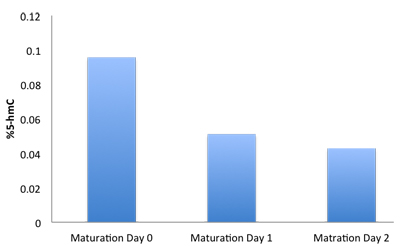Pediatrics / Steiner Lab / Current Research Projects / Role of TET2 & 5-hmC in Hematopoiesis & Leukemogenesis
Investigation into the role of TET2 and 5-hmC in hematopoiesis and leukemogenesis

Elisa data demonstrating that 5-hydroxymethyl cytosine (5-hmC) is present in erythroid precursors
and that the level of 5-hmC declines with erythroid maturation.
Epigenetic modifications are covalent modifications to DNA, or DNA binding proteins (histones), which are maintained throughout multiple cell divisions and are important for the regulation of DNA expression. Epigenetic modifications are a critical mechanism of gene regulation during hematopoiesis, and disruptions of these regulatory mechanisms have been associated with malignant transformation.
Until recently, the only covalent DNA modification known to occur in mammals was the methylation of cytosine in CpG dinucleotides (5-mC), which is generally associated with gene repression. The connection between aberrant DNA methylation (5-mC) and malignant transformation is well established, with cancer cells frequently showing global hypomethylation, with localized hypermethylation at promoters which control cell cycle, tumor suppressor, or DNA-repair genes.
5-hydroxymethylcytosine (5-hmC) is a novel covalent modification of DNA, which is generated by the conversion of 5-mC to 5-hmC by the TET (Ten Eleven Translocation) family of proteins. TET2 and 5-hmC are important in the maintenance and differentiation of hematopoietic stem cells (HSCs) and are thought to play a role malignant transformation.
This project aims to elucidate the molecular mechanisms by which the TET2/5-hmC pathway influences gene expression in both normal and malignant cells.